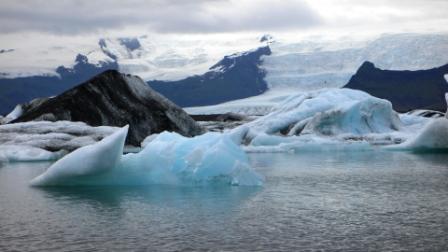
He is now doing it again.
His latest research pointed to a conclusion that was so startling that he did not wait for formal review, but instead last summer (2015) he called a press conference and passed out drafts of his findings.
After many months of some rather unusual and quite intense and rigorous examination, the peer-review process was completed. The paper was then finally published last March within the journal of Atmospheric Chemistry and Physics.
Entitled, “Ice melt, sea level rise and superstorms: evidence from paleoclimate data, climate modeling, and modern observations that 2 °C global warming could be dangerous“, Hanson, along with 18 co-authors, lays out a case that what is coming soon is greatly accelerated sea level rise and also the shutting down of the oceanic circulation systems as a trigger for superstorms. The abstract lays out the paper’s content as follows …
We use numerical climate simulations, paleoclimate data, and modern observations to study the effect of growing ice melt from Antarctica and Greenland. Meltwater tends to stabilize the ocean column, inducing amplifying feedbacks that increase subsurface ocean warming and ice shelf melting. Cold meltwater and induced dynamical effects cause ocean surface cooling in the Southern Ocean and North Atlantic, thus increasing Earth’s energy imbalance and heat flux into most of the global ocean’s surface. Southern Ocean surface cooling, while lower latitudes are warming, increases precipitation on the Southern Ocean, increasing ocean stratification, slowing deepwater formation, and increasing ice sheet mass loss. These feedbacks make ice sheets in contact with the ocean vulnerable to accelerating disintegration. We hypothesize that ice mass loss from the most vulnerable ice, sufficient to raise sea level several meters, is better approximated as exponential than by a more linear response. Doubling times of 10, 20 or 40 years yield multi-meter sea level rise in about 50, 100 or 200 years. Recent ice melt doubling times are near the lower end of the 10–40-year range, but the record is too short to confirm the nature of the response. The feedbacks, including subsurface ocean warming, help explain paleoclimate data and point to a dominant Southern Ocean role in controlling atmospheric CO2, which in turn exercised tight control on global temperature and sea level. The millennial (500–2000-year) timescale of deep-ocean ventilation affects the timescale for natural CO2 change and thus the timescale for paleo-global climate, ice sheet, and sea level changes, but this paleo-millennial timescale should not be misinterpreted as the timescale for ice sheet response to a rapid, large, human-made climate forcing. These climate feedbacks aid interpretation of events late in the prior interglacial, when sea level rose to +6–9 m with evidence of extreme storms while Earth was less than 1 °C warmer than today. Ice melt cooling of the North Atlantic and Southern oceans increases atmospheric temperature gradients, eddy kinetic energy and baroclinicity, thus driving more powerful storms.
The modeling, paleoclimate evidence, and ongoing observations together imply that 2 °C global warming above the preindustrial level could be dangerous. Continued high fossil fuel emissions this century are predicted to yield (1) cooling of the Southern Ocean, especially in the Western Hemisphere; (2) slowing of the Southern Ocean overturning circulation, warming of the ice shelves, and growing ice sheet mass loss; (3) slowdown and eventual shutdown of the Atlantic overturning circulation with cooling of the North Atlantic region; (4) increasingly powerful storms; and (5) nonlinearly growing sea level rise, reaching several meters over a timescale of 50–150 years. These predictions, especially the cooling in the Southern Ocean and North Atlantic with markedly reduced warming or even cooling in Europe, differ fundamentally from existing climate change assessments. We discuss observations and modeling studies needed to refute or clarify these assertions.
There is no way of avoiding the observation that this is truly scary stuff.
If he is correct, then we will experience rapid sea-level rise at a pace that is way beyond the previously prevailing consensus because it will not rise in a linear fashion. To be precise, he is suggesting several meters in the next 50 to 150 years and that would be really bad news for most costal cities on the planet … New York, London, etc…
Let me spell that out for you another way, the average elevation of Florida is just 6 feet, and much of it is just 3 feet above sea level.
Being able to adapt to several additional meters of sea level rise will be a huge challenge, especially if it will happen soon, very soon.
If Hansen is right, 2°C of warming might mean the end for much of NL. Adapting to several metres of sea level rise within a century is tough
— Kees van der Leun (@Sustainable2050) March 22, 2016
“Ice sheet loss is non linear by nature, You push the ice sheet one way, they do not react; you push them more, they start reacting; you keep pushing and they fall apart. … If we get there, we won’t be able to fix it.” – Eric Rignot, Hanson’s co-author
Apart from sea level rising, the other big issue also explored within Hanson’s paper is the possibility of superstorms. The melt pouring into the oceans may possibly trigger a halt to the oceanic heat circulation system (in fact it may already be starting to happen). Once that happens then heat distribution will instead take place within the atmosphere, and that leads to superstorms.
Bottom line: doing nothing about climate change is really not an option.
“What we’re threatening to do to the future of young people is … irreversible, irreparable harm,” – James Hansen
The Video
Mr Hanson also has recorded the following 15 minutes video to accompany the paper. In it he lays out the rather stark warning that we are facing the real possibility of the lose of all our costal cities along will all the history. I should also advise that he does get a bit technical in places.